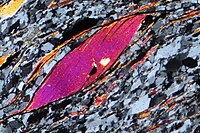Texture (geology)

Imagine you are playing with playdough. You can make it into different shapes and sizes. But have you ever noticed that the playdough can also feel different? Some parts may be smooth while other parts may be rough, bumpy or have little holes in them. That feeling of the playdough is called texture.
In geology, texture is the way rocks and minerals feel and look. Just like playdough, rocks and minerals can also have different textures. Some rocks may be smooth and shiny, while others may be rough and dull.
Texture can be affected by many things. For example, if a rock is made up of many small grains stuck together, it may feel rough or grainy. If a rock was formed from a liquid like lava that cooled slowly, it may have a smooth texture.
Geologists use texture to help them identify different types of rocks and minerals. They can look and feel the rocks to figure out how they were formed and what they are made of. Texture can also tell geologists about the environment the rock was formed in.
So, texture is like how different parts of playdough feel and can help geologists figure out what rocks and minerals are made of and how they were formed.
In geology, texture is the way rocks and minerals feel and look. Just like playdough, rocks and minerals can also have different textures. Some rocks may be smooth and shiny, while others may be rough and dull.
Texture can be affected by many things. For example, if a rock is made up of many small grains stuck together, it may feel rough or grainy. If a rock was formed from a liquid like lava that cooled slowly, it may have a smooth texture.
Geologists use texture to help them identify different types of rocks and minerals. They can look and feel the rocks to figure out how they were formed and what they are made of. Texture can also tell geologists about the environment the rock was formed in.
So, texture is like how different parts of playdough feel and can help geologists figure out what rocks and minerals are made of and how they were formed.
Related topics others have asked about:
